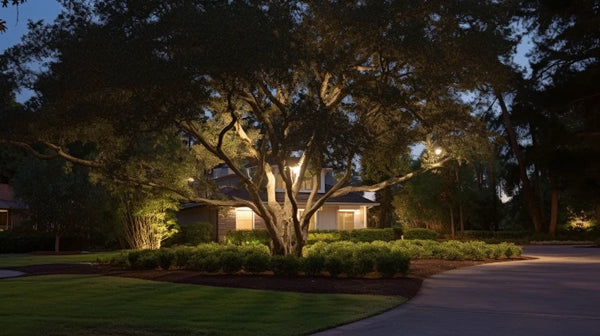Key Differences Between Downlighting and Moon Lighting: Which One's Right for You?

Two techniques prominently stand out in landscape lighting: downlighting and moonlighting. While both aim to illuminate and accentuate outdoor spaces, they offer different atmospheres, aesthetics, and purposes. This guide will highlight the crucial differences between these two techniques, helping you choose the one that suits your space best.
What's the difference between downlighting and moonlighting?
Downlighting is a technique that involves placing light fixtures high up, typically in trees or on structures, and aiming them downwards to highlight specific areas, features, or plantings below.
On the other hand, moonlighting seeks to replicate natural moonlight's soft, ambient glow by placing fixtures at elevated heights and letting the light cascade downward, creating a diffuse illumination reminiscent of a full moon's glow.
Historical Context and Evolution
Downlighting: A Modern Aesthetic
Downlighting originated as a response to the contemporary architectural movement, emphasizing clean lines and minimalist aesthetics. It found its place in enhancing urban landscapes, architectural features, and intricate garden designs.
Moon Lighting: Echoes of Nature
Moonlighting draws inspiration from nature, aiming to replicate the ethereal, gentle glow of moonlight, enveloping the landscape in a mysterious and natural ambiance.
Primary Use Cases
Downlighting: Precision and Highlight
Downlighting is often used in gardens, driveways, and architectural landscapes where specific elements like statues, fountains, or unique plantings need focused illumination.
Moon Lighting: Ambience and Coverage
Moonlighting is about creating an expansive, soft ambiance suitable for larger areas, pathways, and recreational spaces where a subtle, overarching illumination is desired.
Installation and Maintenance
Downlighting: Elevated and Specific
Installing downlights requires precise placement and angle adjustments to ensure the target area is appropriately illuminated without causing harsh shadows or glare.
Moon Lighting: High and Diffuse
Moonlights are typically mounted higher up, ensuring the light scatters and diffuses over a broader area. Maintenance involves regular checks to prevent any obstruction from tree growth.
Energy Consumption and Efficiency
Downlighting: Targeted and Efficient
Given its specific nature, downlighting can often be more energy-efficient as it targets smaller areas precisely.
Moon Lighting: Broad and Balanced
While moonlighting can sometimes use more energy due to its broader coverage, advancements in LED technology have made it increasingly efficient.
Aesthetic Outcomes
Downlighting: Dramatic and Focused
Downlighting is your answer if you want to create a dramatic effect. It can spotlight a garden feature, making it the landscape's star.
Moon Lighting: Natural and Soothing
Moonlighting imparts a gentle, ethereal ambiance to landscapes reminiscent of calm nights under a silvery moon.
Cost Implications
Downlighting: Investment in Precision
Due to its targeted nature, downlighting might sometimes require fewer fixtures but more intricate installation processes.
Moon Lighting: Cost for Coverage
Moonlighting might necessitate more fixtures for adequate coverage, potentially increasing initial setup costs.
Versatility and Adaptability
Downlighting: Fixed and Functional
Downlighting is often more static, illuminating specific targets. Changing the lighting effect might require repositioning or adding fixtures.
Moon Lighting: Flexible and Forgiving
Due to its broader and diffused nature, moonlighting is more adaptable to landscape changes without needing significant lighting adjustments.
FAQs
What are the main benefits of downlighting?
Downlighting offers precise, dramatic illumination, perfect for showcasing specific landscapes or architectural features.
How does moonlighting affect the overall mood of a landscape?
Moonlighting provides a soft, natural ambiance, creating a serene and tranquil mood reminiscent of moonlit nights.
Which lighting technique is more energy-efficient?
While both techniques have their efficiencies, downlighting, being more targeted, might sometimes be more energy-efficient.
Can I combine both downlighting and moonlighting in one landscape?
Absolutely! Many landscape designers blend both techniques to achieve a balanced illumination, highlighting specific features while maintaining an overall ambiance.
How often do moonlights require maintenance?
Depending on the surrounding vegetation, given their elevated placement, moonlights might require periodic checks to ensure unobstructed light distribution.
Are there any safety concerns with downlighting?
As with any lighting, proper installation is crucial. Ensuring that downlights are securely mounted and away from flammable materials is vital.
Conclusion
Understanding their distinctions is essential whether you're leaning towards the focused drama of downlighting or the expansive, natural glow of moonlighting. Both offer unique atmospheres and functionalities; often, a blend of the two can yield the most captivating results. Remember, the key is envisioning the ambiance you desire and selecting the best technique with your vision.
